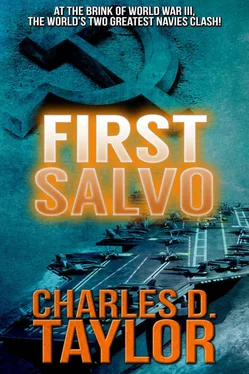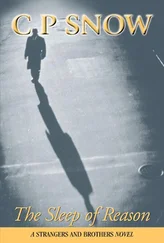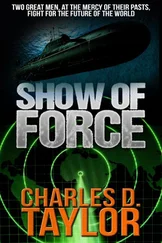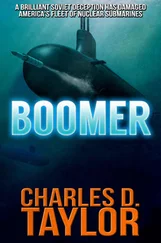Nelson had four ships in line at broad intervals. They were at high speed and each ship had a helicopter working in tandem with it in much the same pattern Nelson had taught them the previous day. It was the equivalent of eight ships, as far as Nelson was concerned. That made it even, perhaps gave him a slight advantage, because the subs had no idea where the helicopters might be until they heard the ping of the dipping sonar. If a helo was lucky and lowered his sonar near a submarine, a homing torpedo could be launched well before the sub could piece together what was taking place.
But on the other hand, a cruise missile launched from beneath the surface also presented a formidable advantage.
There were four of these missiles now rocketing toward the surface ships. The lock-on warning buzzer indicated John Hancock was a target. Chaff rockets were automatically fired to draw the missile off target. Deep within the ship, a computer fed continual solutions into the missile-defense system. First Hancock , then Conolly , then Spruance fired Sea Sparrows at the oncoming missiles.
A submarine-launched cruise missile is intended to fly at low level, low enough to deter radar acquisition, or at least make a fire-control solution complicated. They are not exceptionally fast as missiles go, but they are persistent, designed to correct their course against the actions of their target. They are difficult to defend against. Only one of the Sea Sparrows met with success.
Three missiles bore in on the destroyers now. An anxious Conolly fired a second missile — too late. Her Phalanx system opened fire; this time she was lucky — the hail of bullets destroyed the warhead within a hundred yards of the ship.
Spruance had less success. Her radar lost contact with the incoming missile only for an instant, but the time lost in reacquisition delayed the Gatling gun just long enough. When it did open fire, the missile was diving for Spruance’s flight deck. It penetrated through officers’ quarters, exploding in the ship’s laundry. The force of the blast blew upward, unseating the huge ASROC launcher that allowed the luxury of firing torpedoes from a distance.
The last missile was drawn off her target by the chaff and exploded harmlessly, well away from Hancock.
Two of the helos were able to pinpoint one of the missile-firing submarines. They released torpedoes less than a minute after the missiles had broken surface. The run time was quick. A resounding underwater explosion rewarded them.
Conolly ’s helo reported a solid contact close to its sonar but was experiencing trouble with the torpedo-release mechanism. Within moments, the mother ship fired her ASROC as a backup. The rocket-propelled torpedo, keying in on the ship’s helo, hit the water less than half a mile from it. Immediately the homing device locked on the target and moments later a second submarine had been hit.
There had been eight Soviet subs divided into three wolf packs. One sub remained on the port bow, two directly ahead, and the helos were bothering them. The intact three-sub pack on the starboard bow had apparently now raced out to the starboard beam of the approaching destroyers. In a one-two-three effort, they launched missiles, then sonar showed them closing in for a probable torpedo attack.
On the port beam, the remaining submarine of the two-boat pack was able to break into torpedo range of Spruance. Unable to use her ASROC, the ship was forced to recall her helo to her defense. As the craft’s sonar lowered onto the water, the first sound that came was that of torpedoes. The water was seemingly filled with them, the high-pitched scream cluttering the entire scope. The first hit Spruance on the port side, exploding into the forward engine room with a force that knocked the outboard turbine engine into the other. Blazing fuel wiped out the entire crew in that space. Still reeling from the force of the first torpedo, a second struck amidships. The hits were so close that the port side of the ship opened to the sea for more than fifty feet. Watertight compartments, intended to limit flooding, were ripped open by the pressure. Immediately, Spruance listed heavily to port, her speed cut to only a few knots to slow the flooding. She was out of the battle.
Nelson saw that the integrity of his line was breaking up. The Soviet tactics were obvious; they intended to separate the ships, isolate them. One submarine, the one that hit Spruance , remained to port. The hell with it! Two more were dead ahead but were dodging helos. The immediate threat was to starboard — still three of them out there. They had just launched missiles and were now closing in!
He wheeled his three remaining ships to starboard. In a ragged column, they raced down the throats of the closing wolf pack. Briscoe was point and the only ship not yet required to defend herself. Turning slightly to port, she fired her Sea Sparrow launcher. The closest incoming missile had been diverted by chaff and was flying an erratic course. The Sparrow brought it down. Conolly ’s Phalanx activated as the next missile raced directly at her. She had turned to starboard to open her radar-controlled gun. The missile burst at forty yards, showering the superstructure with debris. The interior of her pilothouse was shattered. Conolly , with no control from her bridge, steamed blindly away from the column.
Nelson ordered one of the helos ahead of them to cover for the damaged ship. John Hancock and Briscoe continued at flank speed toward the submarines. At maximum range, they fired rocket-propelled torpedoes from their ASROC launchers. In concert with the two ships, the one helo in front also dropped its remaining torpedo.
Before the ship’s torpedoes even hit the water, their sonarmen identified high-speed screw noises. The Soviets had torpedoes in the water ahead of them. Doctrine said that each sub would fire a spread of at least two torpedoes — as many as six could be heading toward the ships.
The second helo coming into the area was vectored over a sonar contact by Hancock and, without taking the time to dip her sonar, dropped another homing torpedo. It was contrary to everything Nelson had learned, but he had once run a program to determine hit possibilities in such a case; the chances weren’t much less in this situation than in a controlled attack. There were at least three submarines down there making noise that would attract a homing torpedo.
An explosion astern of the damaged Conolly accounted for the first enemy torpedo; it also meant one less decoy. A second blast lifted the ship’s stern clear of the water. Seemingly before she settled, a third torpedo struck under the forward gun mount. The resulting explosion was a combination of torpedo warhead and the forward magazine. Nelson heard the bridge report that Conolly had neither a bow nor a stern; what remained was swept with flames. Two ships left!
The sea ahead of them erupted. Briscoe ’s lookouts reported wreckage boiling to the surface at the same time her sonarmen reported secondary underwater explosions. A submarine had been hit! The second helo, arriving on station, had just reported torpedoes still running when another undersea blast occurred less than a mile away. A second sub!
Two destroyers and one submarine were left in that sector. But there was no way to locate it. No sonar could penetrate through the underwater mess to locate the last sub. And nothing was more dangerous than a high-speed submarine, one that knew it was free to move for a period of time without detection.
Nelson wheeled the two remaining ships about, reversing course. The sub had the upper hand for the time being. There was no reason to offer two perfect targets. Only John Hancock had a second helo available. She couldn’t recover, but Nelson could launch the remaining one. It had been armed and was ready in one hangar, and now he ordered it rolled out for launch.
Читать дальше












